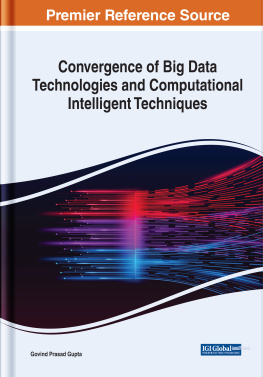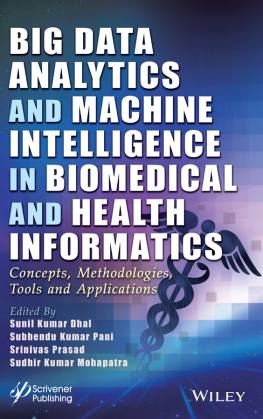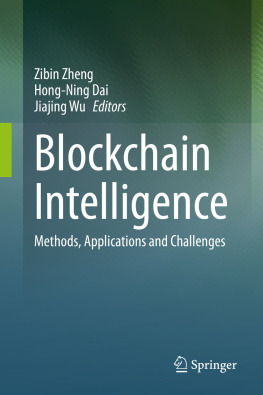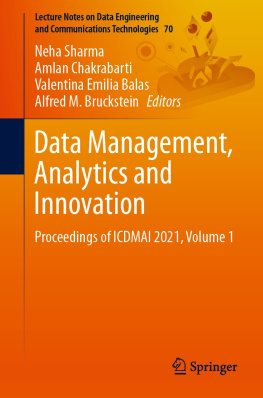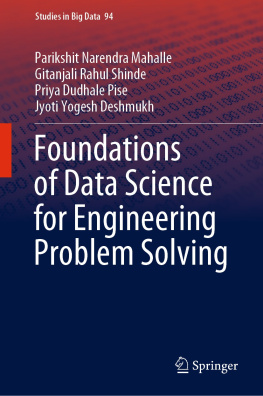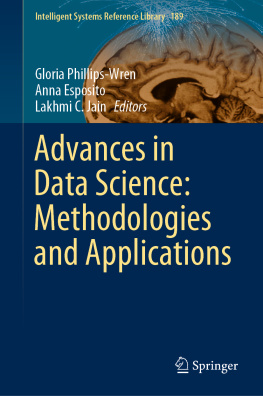Scrivener Publishing
100 Cummings Center, Suite 541J
Beverly, MA 01915-6106
Publishers at Scrivener
Martin Scrivener ()
Phillip Carmical ()
Intelligent Data Analytics for Terror Threat Prediction
Architectures, Methodologies, Techniques and Applications
Edited by
Subhendu Kumar Pani
Sanjay Kumar Singh
Lalit Garg
Ram Bilas Pachori
Xiaobo Zhang

This edition first published 2021 by John Wiley & Sons, Inc., 111 River Street, Hoboken, NJ 07030, USA and Scrivener Publishing LLC, 100 Cummings Center, Suite 541J, Beverly, MA 01915, USA
2021 Scrivener Publishing LLC
For more information about Scrivener publications please visit www.scrivenerpublishing.com
All rights reserved. No part of this publication may be reproduced, stored in a retrieval system, or transmitted, in any form or by any means, electronic, mechanical, photocopying, recording, or otherwise,except as permitted by law. Advice on how to obtain permission to reuse material from this title is available at www.wiley.com/go/permissions.
Wiley Global Headquarters
111 River Street, Hoboken, NJ 07030, USA
For details of our global editorial offices, customer services, and more information about Wiley products visit us at www.wiley.com
Limit of Liability/Disclaimer of Warranty
While the publisher and authors have used their best efforts in preparing this work, they make no representations or warranties with respect to the accuracy or completeness of the contents of this work and specifically disclaim all warranties, including without limitation any implied warranties of merchant-ability or fitness for a particular purpose. No warranty may be created or extended by sales representatives, written sales materials, or promotional statements for this work. The fact that an organization, website, or product is referred to in this work as a citation and/or potential source of further information does not mean that the publisher and authors endorse the information or services the organization, website, or product may provide or recommendations it may make. This work is sold with the understanding that the publisher is not engaged in rendering professional services. The advice and strategies contained herein may not be suitable for your situation. You should consult with a specialist where appropriate. Neither the publisher nor authors shall be liable for any loss of profit or any other commercial damages, including but not limited to special, incidental, consequential, or other damages. Further, readers should be aware that websites listed in this work may have changed or disappeared between when this work was written and when it is read.
Library of Congress Cataloging-in-Publication Data
ISBN 978-1-119-71109-4
Cover image: www.Pixabay.Com
Cover design by Russell Richardson
Set in size of 11pt and Minion Pro by Manila Typesetting Company, Makati, Philippines
Printed in the USA
10 9 8 7 6 5 4 3 2 1
Preface
Intelligent data analytics for terror threat prediction is an emerging field of research at the intersection of information science and computer science. Intelligent data analytics for terror threat prediction is a new era that brings tremendous opportunities and challenges due to easily available criminal data for further analysis. The aim of this data analytics is to prevent threats before they happen using classical statistical issues, machine learning and artificial intelligence, rule induction methods, neural networks, fuzzy logic, and stochastic search methods on various data sources including social media, GPS devices, video feeds from street cameras and license-plate readers, travel and credit-card records and the news media, as well as government and propriety systems. Intelligent data analytics is to ensure the efficient data mining techniques to get solutions for crime investigation. Prediction of future terrorist attacks according to city, attack type, target type, claim mode, weapon type and motive of attack through classification techniques, facilitates the decision making process by security organizations, as well as to learn from the previous stored attack information and then rate the targeted sectors/areas accordingly for security measures. Intelligent data analytics models with multiple level of representation in which at each level the system learns raw to higher abstract level representation. Intelligent data analytics-based algorithms have demonstrated great performance to a variety of areas including data visualization, data pre-processing (fusion, editing, transformation, filtering, and sampling), data engineering, database mining techniques, tools and applications, etc.
This edited book, titled Intelligent Data Analytics for Terror Threat Prediction emerges as a consequence of the vital need for public safety in various domains and parts of the world. It is particularly targeted at resource constrained environments such as in developing nations, where crime is growing at a frightening rate across various domains of life and impeding economic growth. By source constrained situation, we mean environments where crime intelligence skilled personnel are limited and inadequate technological solutions are in place to gather operational safety information for citizens security. In particular, of interest is the quest to realize the nature, scope and level of impact of present crime mining solutions across various domains and to develop novel paradigms for a more comprehensive solution. This will present innovative insights that will help to obtain interventions to undertake emerging dynamic scenarios of criminal activities. Further, this book presents emerging issues, challenges and management strategies in public safety and crime control development across various domains. The book will play a vital role in improving human life to a great extent. All researchers and practitioners will highly benefit from reading this book, especially those who are working in the fields of data mining, machine learning, and artificial intelligence. This book is a good collection on the state-of-the-art approaches for intelligent data analytics. It will be very beneficial for the new researchers and practitioners working in the field to quickly know the best performing methods.
Organization of the Book
This book consists of 14 chapters. It includes quality chapters that present scientific concepts, framework and ideas on intelligent data analytics for terror threat prediction across different crime domains. The editors and expert reviewers have confirmed the high caliber of chapters through careful refereeing of the papers. For the purpose of coherence, we have organized the chapters with respect to similarity of topic addressed. The topics addressed range from crime mining issues pertaining to cyber-crime, cyber-crimes on social media, intrusion detection system, cryptography Internet of Things (IoT) and machine to machine comm. and analysis of crime scenarios.
, Rumor Detection and Tracing its Source to Prevent Cyber-Crimes on Social Media by Ravi Kishore Devarapalli, Anupam Biswas, presents the different automated rumor detection systems in social net-works and techniques to trace the source of rumor.
, Internet of Things (IoT) and Machine to Machine (M2M) Communication Techniques for Cyber Crime Prediction by Jaiprakash Narain Dwivedi presents a response to crime issues by offering a novel security structure that is based on the examination of the limits and capacities of M2M devices and improves the structures headway life cycle for the general IoT natural framework.


